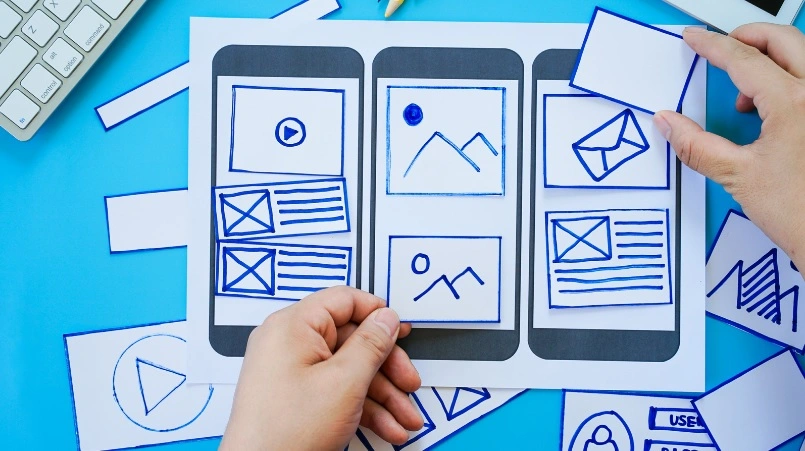A UI/UX development company conducts UI design by focusing on the visual aspects of the interface. It includes the structure, layout, colors, typography, and interactive elements to create an aesthetically pleasing and intuitive experience. For UX design, they analyze user behavior and needs through research and testing to ensure a user-friendly, efficient, and desirable product. Together, these processes aim to deliver a cohesive and engaging user experience. However, for your reference, we will elaborate this whole process in the following sections.
Merits of a UI/UX Development Company
Hiring a UI/UX development company brings numerous benefits to businesses, enhancing the overall user experience and driving better engagement. Here are the key merits:
1. Expertise and Specialization
An agency has skillful professionals with vast knowledge of user interface and user experience design. They employ the latest trends and technologies to deliver cutting-edge solutions.
2. User-Centric Design
Agencies focus on user-centric design, ensuring that the product meets the specific needs and preferences of the target audience. It leads to higher user satisfaction and retention.
3. Improved Usability
By prioritizing usability, UI/UX companies create intuitive and easy-to-navigate interfaces. It reduces the learning curve for users and minimizes errors, enhancing the overall user experience.
4. Consistent Branding
A UI/UX development company ensures that the design is consistent with the brand’s identity. Consistency builds trust and recognition, helping establish a strong brand presence.
5. Increasing Conversion Rates
Well-designed UI/UX can significantly impact conversion rates by providing a seamless and enjoyable user journey. It usually results in higher sales, sign-ups, or other desired actions.
6. Efficient Development Process
By addressing design issues early on, UI/UX companies help prevent costly and time-consuming changes during development. It leads to a more efficient and smooth development process.
7. Competitive Advantage
Investing in professional UI/UX design gives businesses a competitive edge by differentiating their products from competitors. A superior user experience can attract and retain more clients.
UI Design Process
The UI design process involves several stages to create visually appealing and user-friendly interfaces. Here’s a brief overview of the entire process.
1. Research and Analysis
This initial phase involves understanding the project requirements, target audience, and market trends. Designers gather insights through user research, competitor analysis, and stakeholder interviews to inform the design strategy.
2. Wireframing and Prototyping
They create wireframes to outline the basic structure and layout of the interface. It visualizes the content hierarchy and user flow, where prototypes simulate the user experience and interactions, enabling early testing and feedback.
3. Visual Design
This stage focuses on the aesthetic aspects, including color schemes, typography, icons, and images. Designers create high-fidelity mockups that reflect the final look and feel of the product, ensuring alignment with the brand identity.
4. Interaction Design
Designers define how users will interact with the interface, including animations, transitions, and micro-interactions. It enriches the user experience by making the interface more engaging and intuitive.
5. Testing and Iteration
Usability testing aims to gather feedback on the design’s effectiveness and user satisfaction. On the basis of feedback, iterative improvements refine the design for finalization.
6. Implementation and Handoff
The final design is documented and handed over to the development team with detailed specifications and assets. Designers collaborate with developers to ensure accurate implementation and address any design-relevant issues during the development phase.
UX Design Process
The UX design process involves multiple stages aimed at creating a product that provides meaningful and relevant experiences to users. Here’s a concise overview of the process.
1. User Research
The process begins with understanding the users’ needs, behaviors, and motivations through techniques like interviews, surveys, and observation. It helps identify user pain points and goals.
2. Persona Creation
On the basis of research, designers create user personas representing different segments of the target audience. They help guide design decisions by keeping the end-users in mind throughout the process.
3. Information Architecture
Designers organize and structure the content of the product to ensure it is intuitive and easy to navigate. It involves creating site maps and defining the content hierarchy.
4. Prototyping
Interactive prototypes are developed to simulate the user experience. Prototypes let designers test the product’s functionality and gather early feedback from stakeholders and users.
5. Testing
Testing the prototypes with real users helps identify usability issues and areas for improvement. Designers collect feedback and observe how users interact with the product.
6. Finalization
Based on the feedback from testing, designers make necessary adjustments and refinements. The iterative process continues until the product meets the desirable user experience standards.
7. Implementation and Handoff
The final UX design is documented and handed off to the development team, ensuring clear communication of design specifications. UX designers often collaborate with developers to ensure the implementation aligns with the user journey’s vision.
Cohesive Development of the UI/UX Design
Cohesive development of UI (User Interface) and UX (User Experience) design ensures that a digital product is both visually appealing and user-friendly. The process begins with unified research to understand user needs and market trends. UX designers create wireframes outlining the structure, while UI designers add visual elements, ensuring aesthetics enhance functionality.
They develop prototypes to test both visual appeal and user interactions, providing a complete view of the user experience. Consistent visual design and intuitive interactions are prioritized through close collaboration. Iterative testing and feedback refine the design, ensuring usability and visual harmony. Finally, the handoff to the development team, along with ongoing collaboration, sets the pace for the next stage of development.
Conclusion
In this article, we elaborate on the process of UI design and UX design that a UI/UX development company carries out. However, the process involves a list of tools and activities at each stage that might not appear in this writing. Consulting a professional agency lets you focus on other major concerns like promotions and business development. Hire Unique Software Development for your UI/UX design needs and mark an impact where it matters the most.
For more information click here.









